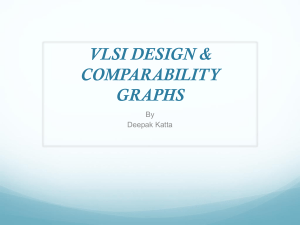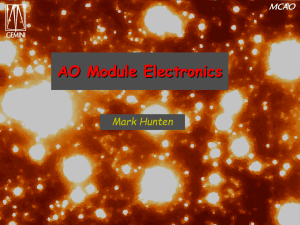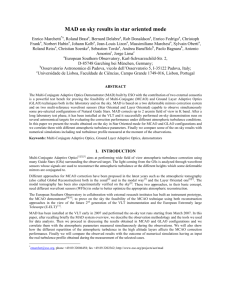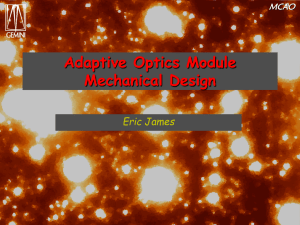Tip-tilt mirror and sensor configuration
advertisement
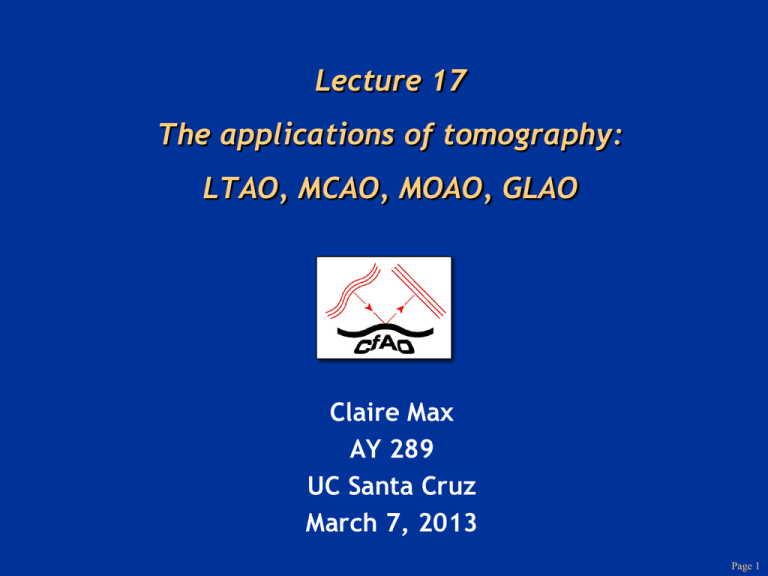
Lecture 17 The applications of tomography: LTAO, MCAO, MOAO, GLAO Claire Max AY 289 UC Santa Cruz March 7, 2013 Page 1 Outline of lecture • What is AO tomography? • AO applications of tomography – Laser tomography AO – Multi-conjugate AO (MCAO) – Multi-object AO (MOAO) – Ground-layer AO (GLAO) • Much of this lecture is based on presentations by Don Gavel, Lisa Poyneer, and Olivier Guyon. Thanks! Page 2 Limitations for AO systems with one guide star • Isoplanatic Angle Limits the corrected field r0 h 0 3 Limitations for AO systems with one guide star • Cone effect 4 Limitations for AO systems with one guide star • Cone effect 1. Missing turbulence outside and above cone 2. Spherical wave “stretching” of wavefront More severe for larger h telescope diameters r0 5 Fundamental problem to solve: Isoplanatic Angle If we assume perfect on-axis correction, and a single turbulent layer at altitude h, the radian) is : 2 variance (sq. 5/3 σ = 1.03 (θ/θ0) Where α is the angle to the optical axis, θ0 is the isoplanatic angle: θ0 = 0.31 (r0/h) D = 8 m, r0 = 0.8 m, h = 5 km => θ0 = 10” h Fundamental problem to solve: Isoplanatic Angle If we assume perfect on-axis correction, and a single turbulent layer at altitude h, the variance (sq. radian) is : σ2 = 1.03 (θ/θ0)5/3 Where α is the angle to the optical axis, θ0 is the isoplanatic angle: θ0 = 0.31 (r0/h) D = 8 m, r0 = 0.8 m, h = 5 km => θ0 = 10” h 90 km Francois Rigaut’s diagrams of tomography for AO Credit: Rigaut, MCAO for Dummies “Missing” Data Page 8 What is Tomography ? 90 km 2. Wider field of view, no cone effect Credit: Rigaut, MCAO for Dummies Tomography lets you reconstruct turbulence in the entire cylinder of air above the telescope mirror Page 9 Concept of a metapupil • Can be made larger than “real” telescope pupil • Increased field of view due to overlap of fields toward multiple guide stars Page 10 How tomography works: from Don Gavel kZ kx < Dk z q = 1 qDz kX ¥ f ( x ) = ò Dn ( x - q z, z ) dz ( ) ( F kx = DN kx ,-kxq ) 0 Fourier slice theorem in tomography (Kak, Computer Aided Tomography, 1988) • Each wavefront sensor measures the integral of index variation along the ray lines • The line integral along z determines the kz=0 Fourier spatial frequency component • Projections at several angles sample the kx,ky,kz volume 11 How tomography works: from Don Gavel kZ kx < Dk z = q 1 qDz kX ¥ f ( x ) = ò Dn ( x - q z, z ) dz F(k x )= DN (k x ,-k xq ) 0 • The larger the telescope’s primary mirror, the wider the range of angles accessible for measurement • In Fourier space, this means that the “bow-tie” becomes wider • More information about the full volume of turbulence above the telescope 12 How tomography works: some math y = Ax • where y = vector of all WFS measurements x = value of OPD) at each voxel in turbulent volume above telescope x y A is a forward propagator • Assume we measure y with our wavefront sensors • Want to solve for x = value of OPD) • The equations are underdetermined – there are more unknown voxel values than measured phases blind modes. Need a few natural guide stars to determine these. Page 13 Solve for the full turbulence above the telescope using the back-propagator x=A y T y = vector of all WFS measurements x x = value of OPD) at each voxel in turbulent volume above telescope y AT is a back propagator along rays back toward the guidestars x Use iterative algorithms to converge on the solution. y Page 14 Tomography movie: Ragazzoni Page 15 LGS Related Problems: “Null modes” • Tilt Anisoplanatism : Low order modes (e.g. focus) > Tip-Tilt at altitude → Dynamic Plate Scale changes • Five “Null Modes” are not seen by LGS (Tilt indetermination problem) → Need 3 well spread NGSs to control these modes Credit: Rigaut, MCAO for Dummies Page 16 Outline of lecture • Review of AO tomography concepts • AO applications of tomography – Laser tomography AO – Multi-conjugate AO (MCAO) – Multi-object AO (MOAO) – Ground-layer AO (GLAO) Page 17 The multi-laser guide star AO zoo (1) Narrow field, suffers from cone effect Narrow field, cone effect fixed Page 18 The multi-laser guide star AO zoo (2) Both correct over a wide field, at a penalty in peak Strehl Page 19 The multi-laser guide star AO zoo (3) Correct over narrow field of view located anywhere w/in wide field of regard Quite modest correction over a very wide field of view Page 20 MCAO on-sky performance MCAO improves image quality where there is no single nearby bright guide star Central parts of the globular cluster Omega Centauri, as seen using different adaptive optics techniques. The upper image is a reproduction of ESO Press Photo eso0719, with the guide stars used for the MCAO correction identified with a cross. A box shows a 14 arcsec area that is then observed while applying different or no AO corrections, as shown in the bottom images. From left to right : No Adaptive Optics, Single Conjugate and Multi-Conjugate Adaptive Optics corrections. SCAO has almost no effect in sharpening the star images while the improvement provided by MCAO is remarkable. Credit: ESO Outline of lecture • Review of AO tomography concepts • AO applications of tomography – Multi-conjugate adaptive optics (MCAO) – Multi-object adaptive optics (MOAO) – Ground-layer AO (GLAO) Page 22 What is multiconjugate AO? Turbulence Layers Deformable mirror Credit: Rigaut, MCAO for Dummies Page 23 What is multiconjugate AO? Deformable mirrors Credit: Rigaut, MCAO for Dummies Turbulence Layers Page 24 The multi-conjugate AO concept Turb. Layers #2 #1 Telescope WFS DM1 DM2 Atmosphere UP Credit: Rigaut, MCAO for Dummies Page 25 Difference between Laser Tomography AO and MCAO • Laser Tomography AO can be done with only 1 deformable mirror • If used with multiple laser guide stars, reduces cone effect • MCAO uses multiple DMs, increases field of view Page 26 “Star Oriented” MCAO Guide Stars • Each WFS looks at one star • Global Reconstruction High Altitude Layer • n GS, n WFS, m DMs • 1 Real Time Controller Ground Layer • The correction applied at each DM is computed using all the input data. Telescope DM2 DM1 WFC WFSs Credit: N. Devaney Page 27 Layer Oriented MCAO • Layer Oriented WFS architecture Guide Stars • Local Reconstruction • x GS, n WFS, n DMs High Alt. Layer • n RTCs Ground Layer • Wavefront is reconstructed at each altitude independently. • Each WFS is optically coupled to all the others. • GS light co-added for better SNR. Telescope DM2 DM1 WFC1 WFC2 WFS1 WFS2 Credit: N. Devaney Page 28 MCAO Simulations, 3 laser guide stars Strehl at 2.2 μm 3 NGS, FoV = 1 arc min Strehl at 2.2 μm 3 NGS, FoV = 1.5 arc min Credit: N. Devaney As field of view increases, average Strehl drops and variation over field increasesPage 29 VLT Multi-conjugate AO Demonstrator (MAD) showed that MCAO works • Originally built as a technical demo to exercise in the lab, and then on the sky • Compare layeroriented with staroriented MCAO • Uses natural guide stars Users love it! Became a regular VLT instrument Page 30 Results from ESO’s Multiconjugate AO Demonstrator (MAD) Single Conjugate Effective 0 ~ 20” Multi Conjugate Effective 0 ~ 40-50” Page 31 Science papers with MAD: Orion star cluster • MCAO correction is clearly better than single conjugate AO, but this is the case all across the image (not clear what 0 is doing) Page 32 Orion star cluster with MAD, continued Page 33 Jupiter with MAD: single conjugate AO has done as well or better than MCAO MAD MCAO Regular Keck AO Jupiter is about 30” across Page 34 Early impressions of MCAO performance based on MAD results to date • Can extend 0 from ~ 20 arc sec all the way to ~ 60” • Some penalty in peak Strehl, in return for larger corrected field • But really need three guide stars - hard to find if using “real” stars. (Hence MAD’s lopsided Strehl maps.) • MCAO should really excel with laser guide stars – Gemini South’s GEMS is first to do this • Note: Solar AO has demonstrated benefits of MCAO using multiple “regions of interest” as wavefront references Page 35 GEMS image of star formation in Orion Page 38 • Orion star forming region: • Compare GEMS MCAO with ALTAIR single conjugate AO on Gemini North Telescope ALTAIR GEMS Outline of lecture • Review of AO tomography concepts • AO applications of tomography – Multi-conjugate adaptive optics (MCAO) – Multi-object adaptive optics (MOAO) – Ground-layer AO (GLAO) Page 40 Distinctions between multi-conjugate and multi-object AO ? 1-2 arc min • DMs conjugate to different altitudes in the atmosphere • Only one DM per object, conjugate to ground • Guide star light is corrected by DMs before its wavefront is measured • Guide star light doesn’t bounce off small MEMS DMs in multi-object spectrograph Page 41 Multi-Object AO • Correct over multiple narrow fields of view located anywhere w/in wide field of regard • In most versions, each spectrograph or imager has its own MEMS AO mirror, which laser guide star lights doesn’t bounce off of • Hence this scheme is called “open loop”: DM doesn’t correct laser guide star wavefronts before LGS light goes to wavefront sensors • In one version, each LGS also has its own MEMS correction Page 42 Science with MOAO: multiple deployable spatially resolved spectrographs • A MEMS DM underneath each high-redshift galaxy, feeding a narrow-field spatially resolved spectrograph (IFU) • No need to do AO correction on the blank spaces between the galaxies Page 43 Why does MOAO work if there is only one deformable mirror in the science path? 90 km • Tomography lets you measure the turbulence throughout the volume above the telescope Page 44 Why does MOAO work if there is only one deformable mirror in the science path? 90 km • Tomography lets you measure the turbulence throughout the volume above the telescope • In the direction to each galaxy, you can then project out the turbulence you need to cancel out for that galaxy Page 45 Existing and Near-Term MOAO Systems • CANARY (Durham, Obs. de Paris, ONERA, ESO) – MOAO demonstrator for E-ELT – On William Herschel Telescope; one arm – Had already commissioning run – First NGS (done), then Rayleigh guide stars • RAVEN (U Victoria, Subaru, INO, Canadian NRC) – And Celia Blain! – MOAO demonstrator for Subaru telescope – 3 NGS wavefront sensors – Field of regard > 2.7 arc min – Will feed an IR science camera – Delivery in 2012 Page 46 VILLAGES at Lick Observatory: Demonstration of Open-Loop Performance • Initial demonstration of open-loop MEMS performance – VILLAGES experiment on 1-meter telescope at Mount Hamilton (Lick Observatory) – It works! Page 48 Page 49 Both E-ELT and TMT have done early designs for MOAO systems • Artist’s sketch of EAGLE MOAO system for E-ELT • One of the constraints is that the spectrographs are very large! • Hard (and expensive) to fit in a lot of them Page 50 Outline of lecture • Review of AO tomography concepts • AO applications of tomography – Multi-conjugate adaptive optics (MCAO) – Multi-object adaptive optics (MOAO) – Ground-layer AO (GLAO) Page 51 Ground layer AO: do tomography, but only use 1 DM (conjugate to ground layer) MCAO GLAO single DM conjugated to ground layer GLAO uses 1 ground-conjugated DM, corrects near-ground turbulence Credit: J-M Conan Page 52 Correcting just the ground layer gives a very large isoplanatic angle • Strehl = 0.38 at θ = θ0 θ0 is isoplanatic angle -3 / 5 ¥ é ù 2 8/3 2 5/3 J 0 = ê2.914 k (sec z ) ò dz CN (z) z ú ë û 0 θ0 is weighted by high-altitude turbulence (z5/3) • If turbulence is only at low altitude, overlap is very high. • If you only correct the low altitude turbulence, the isoplanatic angle will be large (but the correction will be only modest) Common Path Telescope Page 53 Ground Layer AO (GLAO) typically decreases natural “seeing” by a factor of 1.5 to 2 • Example: GLAO calculation for Giant Magellan Telescope (M. Johns) • Adaptive secondary conjugation at 160 m above primary mirror. • Performance goals: – > 0.8 μm – Field of view: >10’ – Factor of 1.5-2 reduction in image size. Modeled using Cerro Pachon turbulence profile. (M-L Hart 2003) Page 54 Many observatories have ambitious GLAO projects planned • Near term on medium sized telescopes: SOAR (4.25m), William Herschel Telescope (4.2m), MMT (6.5m) • Medium term on VLT (8m), LBT (2x8m) • Longer term on Giant Magellan Telescope etc. • Is it worth the large investment “just” to decrease “seeing” disk by factor of 1.5 to 2 ? – Depends on whether existing or planned large spectrographs can take advantage of smaller image – Potential improved SNR for background-limited point sources Page 55 time Credit: A. Page 56 Credit: A. Tokovinin Page 57 Initial demonstration of GLAO at MMT • With GLAO, image width is reduced from 0.70 to 0.33 arc sec and peak intensity is increased by factor of 2.3 • Credit: Christoph Baranec, Michael Hart, and colleagues, U AZ Page 58 GLAO at the MMT (Rayleigh guide stars) Page 60 SOAR Telescope Page 61 Summary • Tomography: a way to measure the full volume of turbulence above the telescope • Once you have measured the turbulence there are several ways to do the wavefront correction – Laser Tomography AO: Multiple laser guide stars, 1 DM, corrects cone effect. Narrow field. – Multi-conjugate AO: Multiple DMs, each optically conjugate to a different layer in atmosphere. Wider field of view. – Multi-object AO: Correct many individual objects, each over a small field. Each has very good correction. Wider field of regard. – Ground-layer AO: Correct just ground layer turbulence. Very large field of view but only modest correction. • All four methods will be used in the future Page 62 Backup slides Page 63 Altitude Reconstruction using back-projections with CN2 Cn 2 Dn (Turbulence Strength) GS1 S (Index variations) Projection GS2 z 5-guidestar reconstructions x 2 Cn weighted backprojection Uniformly weighted backprojection Cone (laser guide star) back-projections GS1 S GS2 z Altitude x Dn 3 laser guidestar reconstuction 5 laser guidestar reconstuction 5 natural star reconstuction (Index variations) Page 65





